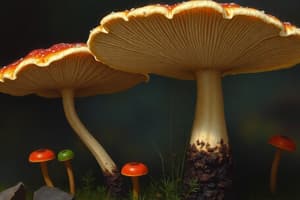Podcast
Questions and Answers
What is unique about the oomycetes?
What is unique about the oomycetes?
- They are single-celled organisms.
- They have plastids and perform photosynthesis.
- They have cell walls made of cellulose.
- They acquire nutrients through parasitism or decomposition. (correct)
What is the function of the alveoli in alveolates?
What is the function of the alveoli in alveolates?
- To store nutrients
- To regulate the cell's water balance
- To provide mechanical support
- Unknown function (correct)
What are the three clades included in the alveolates?
What are the three clades included in the alveolates?
- Dinoflagellates, apicomplexans, and fungi
- Apicomplexans, ciliates, and bacteria
- Oomycetes, fungi, and dinoflagellates
- Dinoflagellates, apicomplexans, and ciliates (correct)
What causes the water to appear brownish red or pink during a red tide?
What causes the water to appear brownish red or pink during a red tide?
What is the effect of red tides on invertebrates and fishes?
What is the effect of red tides on invertebrates and fishes?
What is facilitating more frequent red tides?
What is facilitating more frequent red tides?
What is the characteristic feature of dinoflagellates?
What is the characteristic feature of dinoflagellates?
What is Phytophthora infestans?
What is Phytophthora infestans?
What is the current status of the root of the eukaryotic tree?
What is the current status of the root of the eukaryotic tree?
What is a characteristic feature of the excavates?
What is a characteristic feature of the excavates?
What is the primary source of energy for diplomonads?
What is the primary source of energy for diplomonads?
What is the by-product of anaerobic metabolism in parabasalids?
What is the by-product of anaerobic metabolism in parabasalids?
What is the primary habitat of most diplomonads and parabasalids?
What is the primary habitat of most diplomonads and parabasalids?
What is the function of the 'excavated' feeding groove in some excavates?
What is the function of the 'excavated' feeding groove in some excavates?
Which group of excavates includes the parasite Trichomonas vaginalis?
Which group of excavates includes the parasite Trichomonas vaginalis?
What is the estimated number of people infected with Trichomonas vaginalis per year?
What is the estimated number of people infected with Trichomonas vaginalis per year?
What does the acronym SAR stand for?
What does the acronym SAR stand for?
What is a characteristic feature of stramenopiles?
What is a characteristic feature of stramenopiles?
What is the primary component of a diatom's cell wall?
What is the primary component of a diatom's cell wall?
What is the estimated number of diatom species?
What is the estimated number of diatom species?
Why are diatoms important in the ocean?
Why are diatoms important in the ocean?
What happens to dead diatoms in the ocean?
What happens to dead diatoms in the ocean?
What is the proposed use of diatom blooms in reducing atmospheric CO2 levels?
What is the proposed use of diatom blooms in reducing atmospheric CO2 levels?
Which group of stramenopiles includes brown algae?
Which group of stramenopiles includes brown algae?
What is the characteristic that gives green algae their name?
What is the characteristic that gives green algae their name?
Which group of green algae includes the algae most closely related to plants?
Which group of green algae includes the algae most closely related to plants?
What is the most common environment for chlorophytes?
What is the most common environment for chlorophytes?
What is a key role that protists play in their habitats?
What is a key role that protists play in their habitats?
Which of the following protists is a symbiont that benefits its host?
Which of the following protists is a symbiont that benefits its host?
How do some green algae, such as Caulerpa, achieve larger size and greater complexity?
How do some green algae, such as Caulerpa, achieve larger size and greater complexity?
What is a characteristic of nearly all chlorophyte species?
What is a characteristic of nearly all chlorophyte species?
What is the primary source of energy for photosynthetic protists?
What is the primary source of energy for photosynthetic protists?
What is the effect of adding nutrients to photosynthetic protists?
What is the effect of adding nutrients to photosynthetic protists?
Which process has evolved in some chlorophytes, including Ulva?
Which process has evolved in some chlorophytes, including Ulva?
What is the name of the group that includes protists that are closely related to fungi and animals?
What is the name of the group that includes protists that are closely related to fungi and animals?
What is the consequence of a population boom of photosynthetic protists?
What is the consequence of a population boom of photosynthetic protists?
What is the characteristic of the life cycle of Chlamydomonas, a unicellular chlorophyte?
What is the characteristic of the life cycle of Chlamydomonas, a unicellular chlorophyte?
What is the effect of increasing sea surface temperature on photosynthetic protists?
What is the effect of increasing sea surface temperature on photosynthetic protists?
What is necessary for phytoplankton communities to thrive?
What is necessary for phytoplankton communities to thrive?
What is the effect of warm surface water on phytoplankton communities?
What is the effect of warm surface water on phytoplankton communities?
Flashcards are hidden until you start studying
Study Notes
Eukaryotic Tree and Protists
- The root of the eukaryotic tree is unknown, and new groups of protists have been discovered, but their relationships to supergroups are unresolved.
- Examples of unresolved groups include haptophytes, cryptophytes, and hemimastigophores.
Excavates
- Excavates are characterized by their cytoskeleton and some have an "excavated" feeding groove on one side of the body.
- The excavates include three monophyletic groups: diplomonads, parabasalids, and euglenozoans.
- Diplomonads and parabasalids lack plastids and have reduced mitochondria, and most live in anaerobic environments.
- Diplomonads have two equal-sized nuclei and multiple flagella, and many are parasites, such as Giardia intestinalis.
- Parabasalids have reduced mitochondria, called hydrogenosomes, that generate some energy anaerobically, and release hydrogen gas as a by-product.
SAR Supergroup
- SAR is a monophyletic supergroup named for the first letters of its three major clades: stramenopiles, alveolates, and rhizarians.
- Stramenopiles include some of the most important photosynthetic organisms on Earth, and most have a "hairy" flagellum paired with a "smooth" flagellum.
Stramenopiles
- Diatoms are unicellular algae with a unique two-part, glass-like wall of silicon dioxide, and are an important group of stramenopiles.
- Diatoms are so abundant and widespread that their photosynthetic activity affects global CO2 levels, and promoting diatom blooms by fertilizing the ocean with essential nutrients is a proposed approach to reduce atmospheric CO2 levels.
- Oomycetes are related to plastid-bearing groups, but do not have plastids or perform photosynthesis, and acquire nutrients through parasitism or decomposition.
- Brown algae are another important group of stramenopiles.
Alveolates
- Alveolates have membrane-enclosed sacs (alveoli) just under the plasma membrane, and three clades included in the alveolates are the dinoflagellates, the apicomplexans, and the ciliates.
- Dinoflagellates are abundant components of marine and freshwater phytoplankton, and have two flagella housed in the grooves of armor-like cellulose plates that surround the cell.
- Dinoflagellate blooms cause "red tides" where the water appears brownish red or pink due to the carotenoids present in their plastids, and are toxic and can cause massive kills of invertebrates and fishes.
Green Algae
- Green algae are named for their green chloroplasts, which are structurally and chemically similar to those found in plants, and form a paraphyletic group that includes the charophytes and the chlorophytes.
- Charophytes include the algae most closely related to plants, and most chlorophytes live in fresh water, although there are many marine and some terrestrial species.
- Larger size and greater complexity evolved in green algae by three different mechanisms: formation of colonies, formation of true multicellular bodies, and repeated division of nuclei.
Unikonts
- Unikonts are a supergroup that includes protists that are closely related to fungi and animals.
Protists in Ecological Communities
- Protists are found in diverse aquatic and moist terrestrial environments, and play two key roles in their habitats: that of symbiont and that of producer.
- Some protist symbionts benefit their hosts, while others are parasites.
- Photosynthetic protists are producers, and are limited by nutrients, and populations explode when nutrients are added, leading to major ecological consequences.
- Phytoplankton communities rely on upwelling of cold, nutrient-rich water from the below, and warm surface water acts as a barrier to upwelling.
Studying That Suits You
Use AI to generate personalized quizzes and flashcards to suit your learning preferences.



